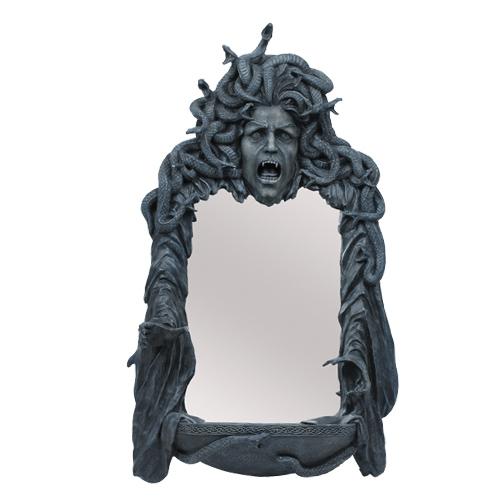The Myth of Medusa: It takes a mirror…..
from Wikepedia
Medusa
The three Gorgon sisters—Medusa, Stheno, and Euryale—were children of the ancient marine deities Phorcys (or Phorkys) and his sister Ceto (or Keto), chthonic monsters from an archaic world. Their genealogy is shared with other sisters, the Graeae, as in Aeschylus’s Prometheus Bound who places both trinities of sisters far off “on Kisthene’s dreadful plain”:
Near them their sisters three, the Gorgons, winged
With snakes for hair— hated of mortal man—
While ancient Greek vase-painters and relief carvers imagined Medusa and her sisters as beings born of monstrous form, sculptors and vase-painters of the fifth century began to envisage her as being beautiful as well as terrifying. In an ode written in 490 BC Pindar already speaks of “fair-cheeked Medusa”.
In a late version of the Medusa myth, related by the Roman poet Ovid, Medusa was originally a ravishingly beautiful maiden, “the jealous aspiration of many suitors,” priestess in Athena’s temple, but when she and the “Lord of the Sea” Poseidon lay together in Athena’s temple, the enraged Athena transformed Medusa’s beautiful hair to serpents and made her face so terrible to behold that the mere sight of it would turn onlookers to stone. In Ovid’s telling, Perseus describes Medusa’s punishment by Minerva (Athena) as just and well-deserved.
In most versions of the story, she was beheaded by the hero Perseus, who was sent to fetch her head by King Polydectes of Seriphos as a gift. With help from Athena and Hermes who supplied him with winged sandals, Hades’ cap of invisibility, a sword, and a mirrored shield, he accomplished his quest. The hero slew Medusa by looking at her harmless reflection in the mirror instead of directly at her, to prevent being turned into stone. When the hero severed Medusa’s head from her neck, two offspring sprang forth, the winged horse Pegasus and the golden-sworded giant Chrysaor.


It is interesting that the Wikipedia article referenced has the following rather than what is stated in this post:
“In a late version of the Medusa myth, related by the Roman poet Ovid (Metamorphoses 4.770), Medusa was originally a ravishingly beautiful maiden, “the jealous aspiration of many suitors,” priestess in Athena’s temple, but when she was caught being raped by the “Lord of the Sea” Poseidon in Athena’s temple, the enraged Athena transformed Medusa’s beautiful hair to serpents and made her face so terrible to behold that the mere sight of it would turn onlookers to stone. In Ovid’s telling, Perseus describes Medusa’s punishment by Minerva (Athena) as just and well earned.”
Note that it states that “she was caught being raped by the “Lord of the Sea” Poseidon” rather than “but when she and the “Lord of the Sea” Poseidon lay together.” This is a very serious change in reference to the myth. Why is there a difference in the wording? The former shows that Medusa was a victim who was then also punished for the crime that was committed against her, whereas the latter portrays her as having done something to warrant some kind of punishment.
Thank you in advance for your explanation.